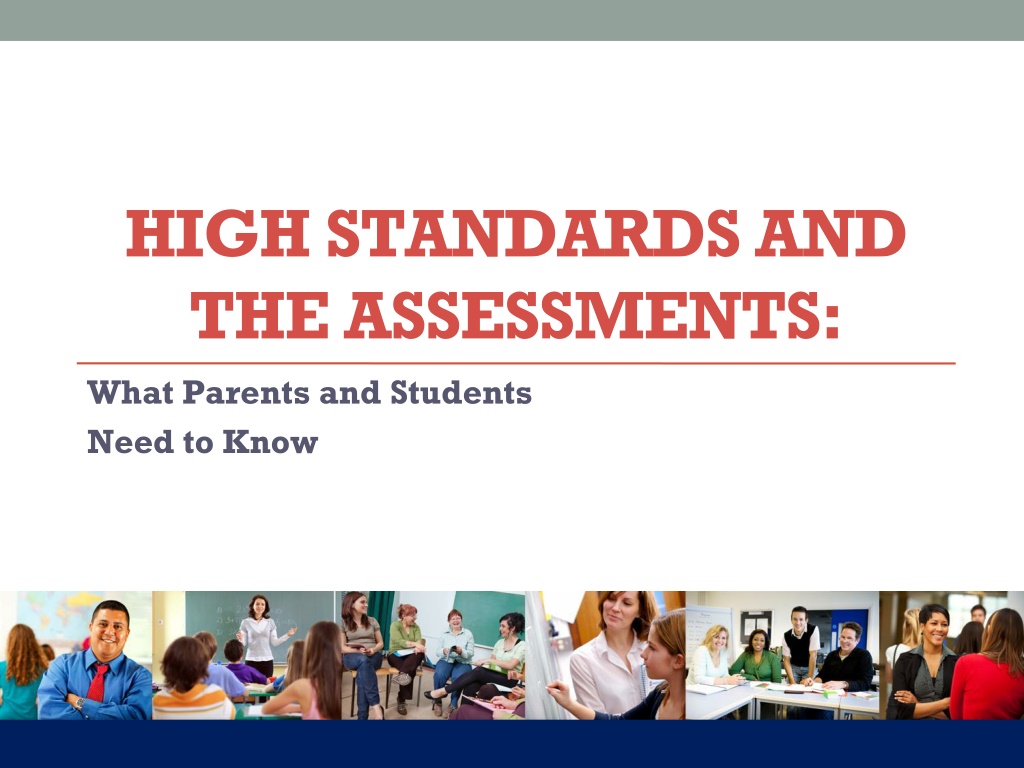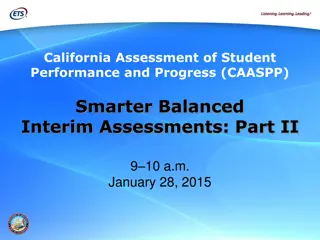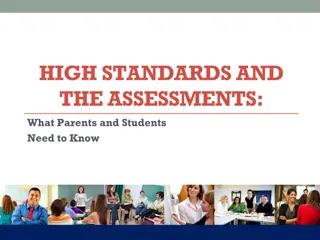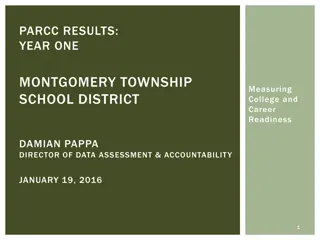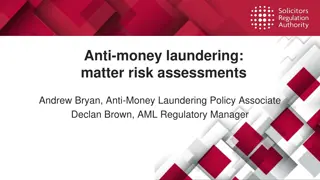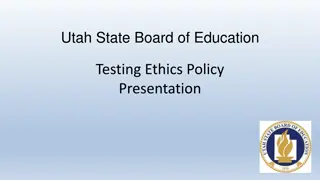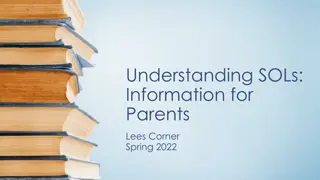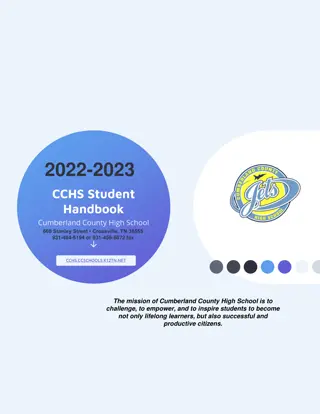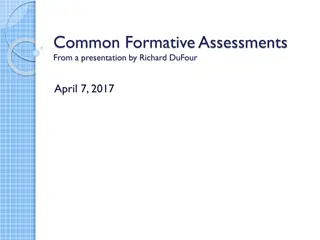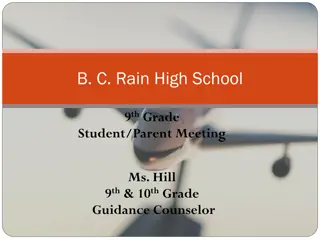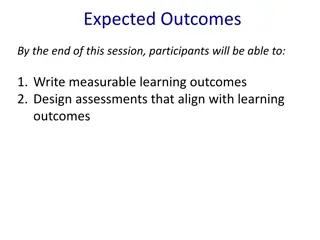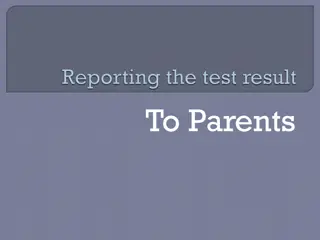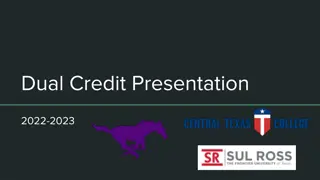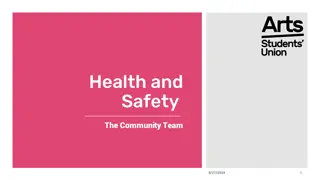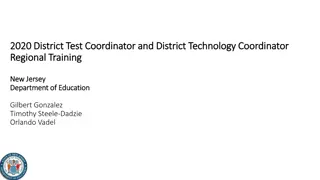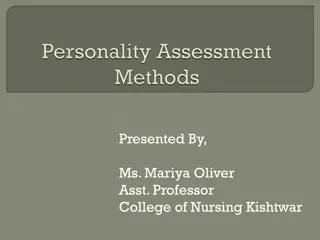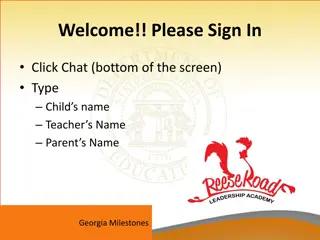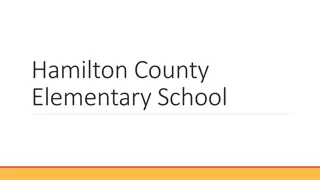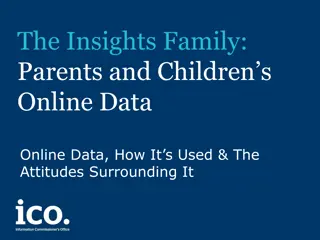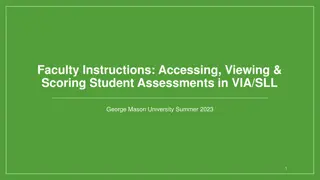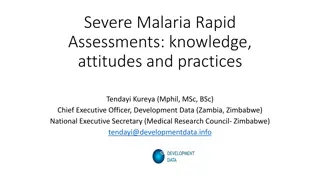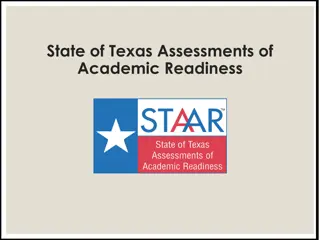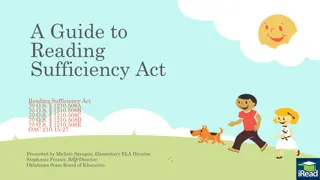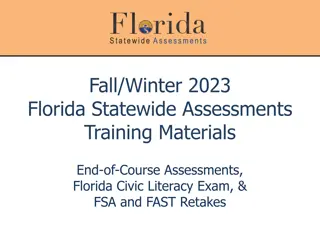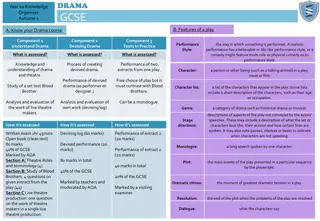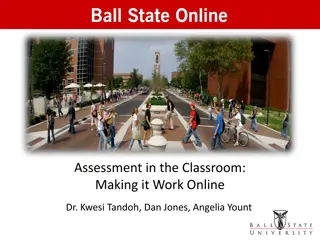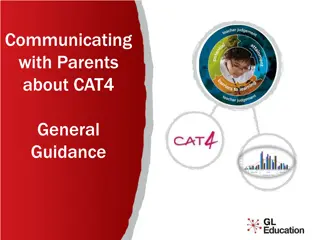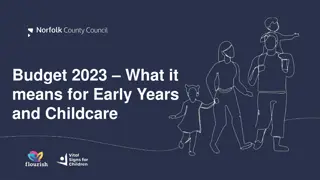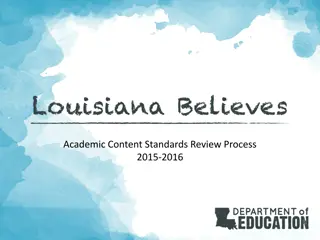Understanding High Standards and Assessments for Parents and Students
Explore the importance of high learning standards and assessments for students, focusing on the shift towards rigorous college and career readiness standards. Learn how parents can support their children in meeting these expectations through the changes in the classroom, teachers' role, and the transition to higher standards. Discover the key areas of focus in ELA/Literacy and Mathematics, emphasizing critical thinking, problem-solving, and academic vocabulary development.
Download Presentation

Please find below an Image/Link to download the presentation.
The content on the website is provided AS IS for your information and personal use only. It may not be sold, licensed, or shared on other websites without obtaining consent from the author. Download presentation by click this link. If you encounter any issues during the download, it is possible that the publisher has removed the file from their server.
E N D
Presentation Transcript
HIGH STANDARDS AND THE ASSESSMENTS: What Parents and Students Need to Know
Agenda The Learning Standards Why Aim High Changes in the Classroom Helping Teachers Help Students Reach the Higher Bar 3-8 Annual Assessments Old versus New Test Facts What s Next for the 3-8 Tests? Q+A 2
The Move to Higher Standards Whether they want to go to college or straight into the workplace, our students need to be able to think critically and solve complex problems. In 2010, the Board of Regents adopted more rigorous, college and career-readiness standards to help ensure our schools are preparing all children for success upon graduation from high school. Why High Learning Standards? They help all children nomatter who they are learn the same skills. They are clear expectations for what your child should know and be able to do in key areas: reading, writing, speaking and listening, language and mathematics. If you know what these expectations are, then you can work with your child s teacher and help your child prepare. 4
Higher Ed Supports Higher Standards https://www.youtube.com/watch?v=ltOCF4cUmTQ 5
High Standards in the Classroom ELA/Literacy Read both non-fiction and fiction Learn about the world by reading Read more challenging material closely Discuss reading using evidence Write non-fiction using evidence Increase academic vocabulary Mathematics Focus: learn more about fewer key topics Build skills within and across grades Develop speed and accuracy Really know it, really do it Use it in the real world Think fast AND solve problems 6
ELA/Literacy: Read as much non fiction as fiction Students Read both non-fiction and fiction Parents can Supply more non- fiction text Know the ways non- fiction can be put together Read non-fiction texts aloud or with your child Have fun with non- fiction in front of them Enjoy and discuss the details of non-fiction 7
ELA/Literacy: Learn about the world by reading Students Parents can Get smart in Science and Social Studies through reading Supply series of texts on topics of interest Find books that explain Handle primary source documents Discuss non-fiction texts and the ideas within Get smarter through texts 8
The more we read the more we can read! By age 3, children from affluent families have heard 30 million more words than children from parents living in poverty (Hart and Risley, 1995). Children who have larger vocabularies and greater understanding of spoken language do better in school (Whitehurst and Lonigan, 1998). If children aren t reading on grade level by third grade, they are four times more likely to leave high school without a diploma (Hernandez, 2011). 9 9
ELA/Literacy: Read more complex material carefully Students Parents can Re-read Provide more challenging texts AND provide texts they WANT to read and can read comfortably Read material at comfort level AND work with more challenging stuff Know what is grade level appropriate Unpack text Handle frustration and keep pushing Read challenging stuff with them Show that challenging stuff is worthunpacking 10
Support their Reading. Read Challenging Texts Aloud. Grades Example of Complexity: Non-fiction Example of Complexity: Fiction K-1 A Tree is a Plant Read Aloud: Fire, Fire! Are you My Mother? Read Aloud: The Owl & the Pussycat 2-3 Martin Luther King and the March on Washington Read Aloud: What the World Eats Fire Cat Read Aloud: Charlotte s Web 4-5 Hurricanes: Earth s Mightiest Storms The Kids Guide to Money Bud not Buddy The Secret Garden 6-8 Narrative of the Life of Frederick Douglass A Night to Remember Little Women The People Could Fly 9-10 Hope, Despair, Memory Letter from Birmingham Jail Things Fall Apart In the Time of Butterflies 11-12 Take the Tortillas Out of Your Poetry Mother Tongue Black Boy The Canterbury Tales Dreaming in Cuban Crime & Punishment 11
ELA/Literacy: Discuss reading using evidence Students Find evidence to support their arguments Parents Can Talk about text Demand evidence in every day discussions/ disagreements Form judgments Become scholars Read aloud or read the same book and discuss with evidence Discuss what the author is up to 12
ELA/Literacy: Writing from Sources Students Make arguments in writing using evidence Parents can Encourage writing at home Compare multiple texts in writing Write books together and use evidence/ details Write well Look at Appendix A: http://www.corestandards.org/assets /Appendix_C.pdf 13
ELA/Literacy: Academic Vocabulary Students Learn the words that they can use in college and career Parents Can Read often and constantly with babies, toddlers, preschoolers, and children Get smarter at using the language of power Read multiple books about the same topic Let your kids see you reading Talk to your children; read to your children; listen to your children; sing with your children; make up silly rhymes and word games with your children 14
Marylin Jager Adams Advancing Our Students Language and Literacy: The Challenge of Complex Texts (American Educator, Winter 2010-2011) What is written is much more complex than what we say. The more children read about a topic, the more they can read about that topic. 15 15
Mathematics: Focus: learn more about less Students Spend more time on fewer concepts Parents Can Know what the priority work is for your child for their grade level Spend time with your child on priority work Ask your child s teacher about their progress on priority work 16
Mathematics: Skills Across Grades Students Keep building on learning year after year Parents Can Be aware of what your child struggled with last year and how that will affect learning this year Advocate for your child and ensure that support is given for gap skills negative numbers, fractions, etc. 17
The National Mathematics Advisory Panels Final Report (2008) Success in College! Success in Algebra Success with Fractions Success with Adding/Subtracting/ Multiplying/Dividing Positive and Negative Numbers Final Report of the National Mathematics Advisory Panel, 2008 18 18
Mathematics: Speed and Accuracy Students Parents Can Spend time practicing lots of problems on the same idea Push children to know/ memorize basic math facts Know all of the fluencies your child should have and prioritize learning of the ones they don t 19
Key Math Fluencies Grade Required Fluency K 1 Add/subtract within 5 Add/subtract within 10 Add/subtract within 20 Add/subtract within 100 (pencil and paper) Multiply/divide within 100 Add/subtract within 1000 Add/subtract within 1,000,000 Multi-digit multiplication Multi-digit division Multi-digit decimal operations Solve px + q = r, p(x + q) = r Solve simple 2 2 systems by inspection 2 3 4 5 6 7 8 20
Mathematics: Know it/Do it! Students UNDERSTAND why the math works. MAKE the math work. Parents Can Notice whether your child REALLY knows why the answer is what it is TALK about why the math works Advocate for the TIME your child needs to learn key math PROVE that they know why and how the math works Provide TIME for your child to work hard with math at home Get smarter in the math your child needs to know 21
Mathematics: Real World Students Parents Can Apply math in real world situations Ask your child to DO the math that comes up in your daily life Know which math to use for which situation 22
Mathematics: Think Fast/Solve Problems Students Be able to use core math facts FAST Parents Can Make sure your child is PRACTICING the math facts he/she struggles with AND Make sure your child is thinking about math in real life Be able to apply math in the real world 23
Helping Teachers Help Students Reach the Higher Bar Increased targeted professional development for teachers to help them help our students meet the higher bar we ve set for them Grants to support teacher coaching/mentoring Vast curriculum library and other instructional materials available for free on EngageNY.org 24
Learning Standards Review The State Education Department is in the process of reviewing New York s Common Core Learning Standards. The Department is seeking feedback from all stakeholders, including educators, parents, and administrators, through an online, public survey. Survey participants will be able to provide input on individual standards. For more information about the survey, visit nysed.gov/AIMHighNY
Grades 3-8 English Language Arts and Math Tests
Annual Grades 3-8 ELA and Math Tests Focus on the more rigorous college and career readiness state standards that are guiding instruction in ELA and math Measure real-world skills Require students to explain their answers and describe and defend their reasoning They measure: Problem solving Writing Critical thinking 27
Your Childs Test Results They serve as an academic checkup to make sure your child is on track for the next grade level. They measure progress over time so you see your child s year-to-year performance. They provide a deeper level of information by pinpointing what skills your child has mastered and what skills he is still developing. 28 28
Test Facts The Annual Grades 3-8 ELA and Math Tests are only one measure of student performance. The results provide objective information about your child s progress compared to other students, school districts, and the state. The annual tests in ELA and math for students in grades 3-8 are federally required; no additional federal or state required tests have been introduced since the adoption of the more rigorous learning standards. New York State teachers assisted with the development and review of each question on the tests. State law forbids using student performance on elementary- and middle- level tests as the sole or primary basis for student placement or promotion decisions. 29 29
Whats next for the 3-8 tests? New test vendor (Questar Assessment) Nearly double the number of NYS teachers will help develop future tests New vendor is working with the Education Department and districts to implement computer-based tests Eventually will lead to reduced testing time and faster results Moving toward: Shorter, more effective tests Reducing the need for stand-alone field tests Releasing more test questions Releasing results before the end of the school year 30
Learn more about the standards and assessments Visit nysed.gov and engageNY.org Talk to your child s teacher 32
